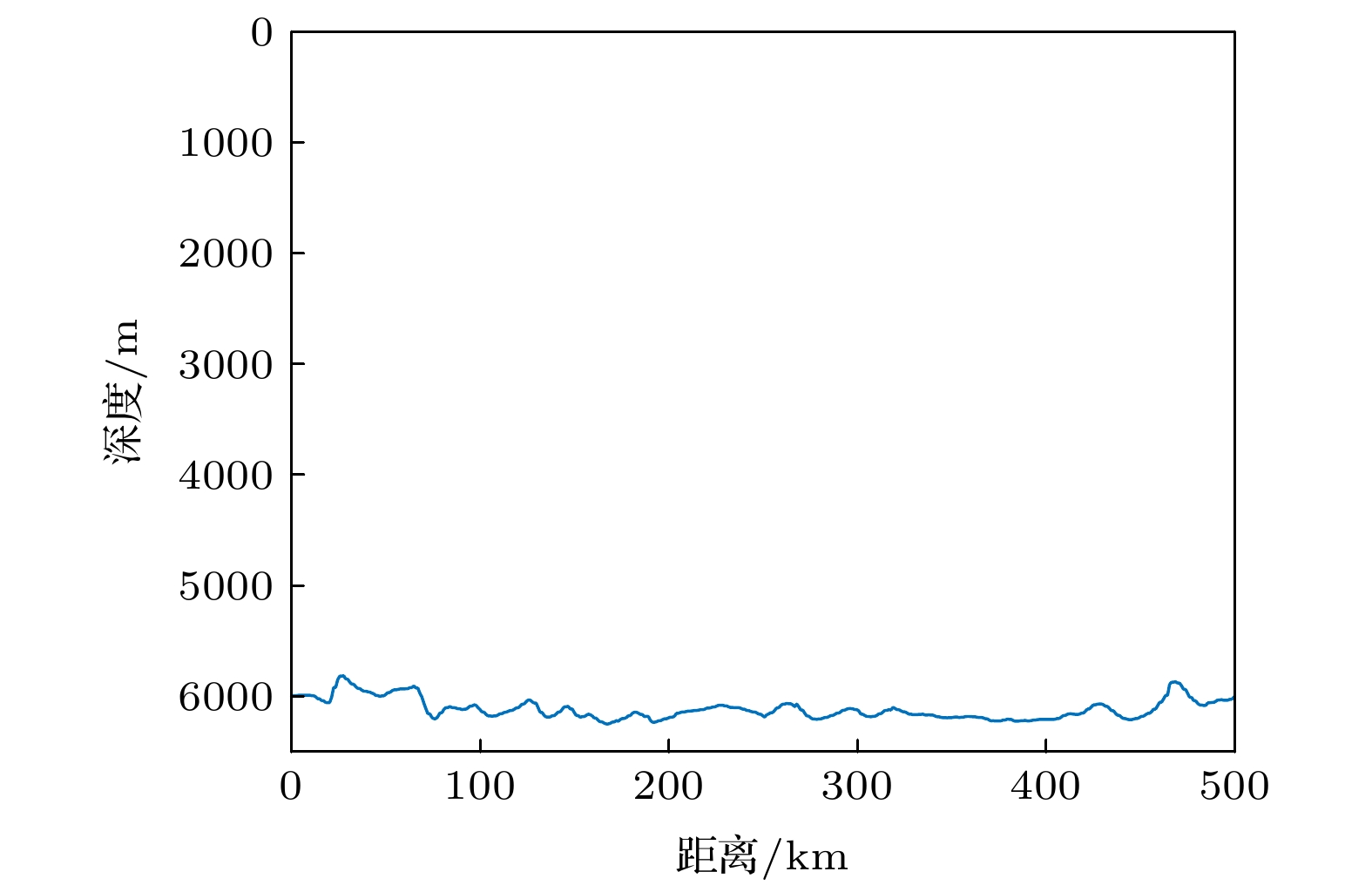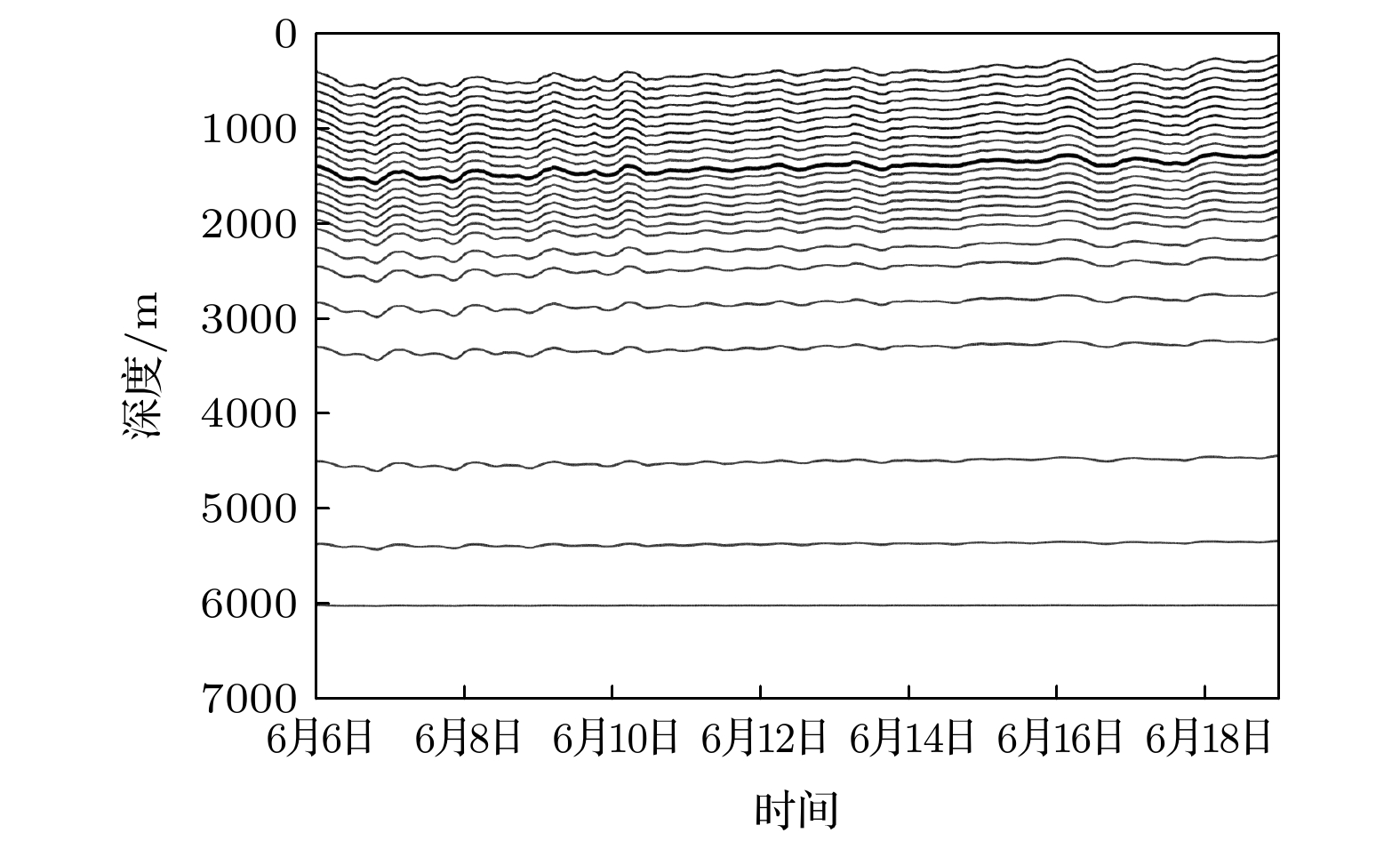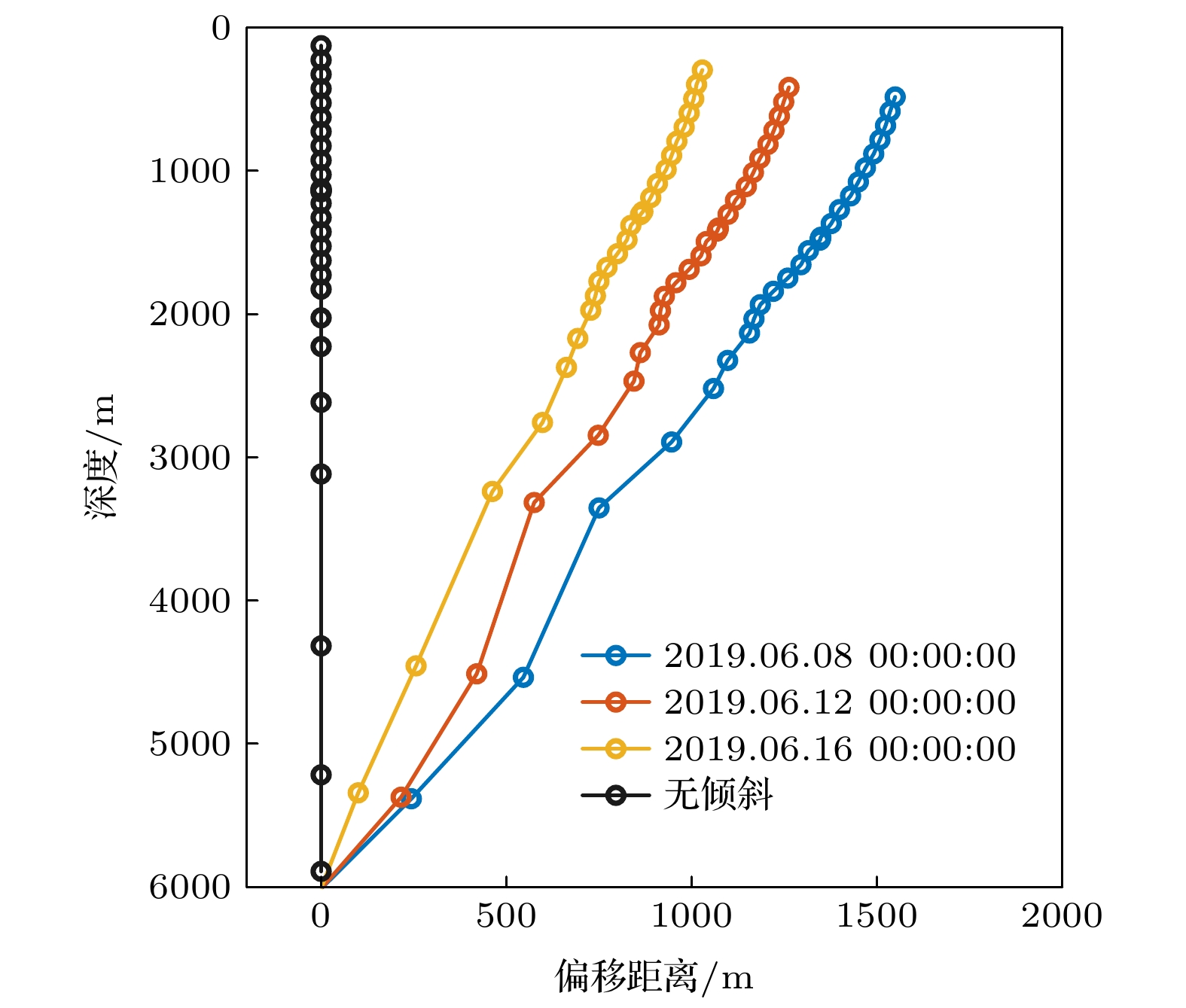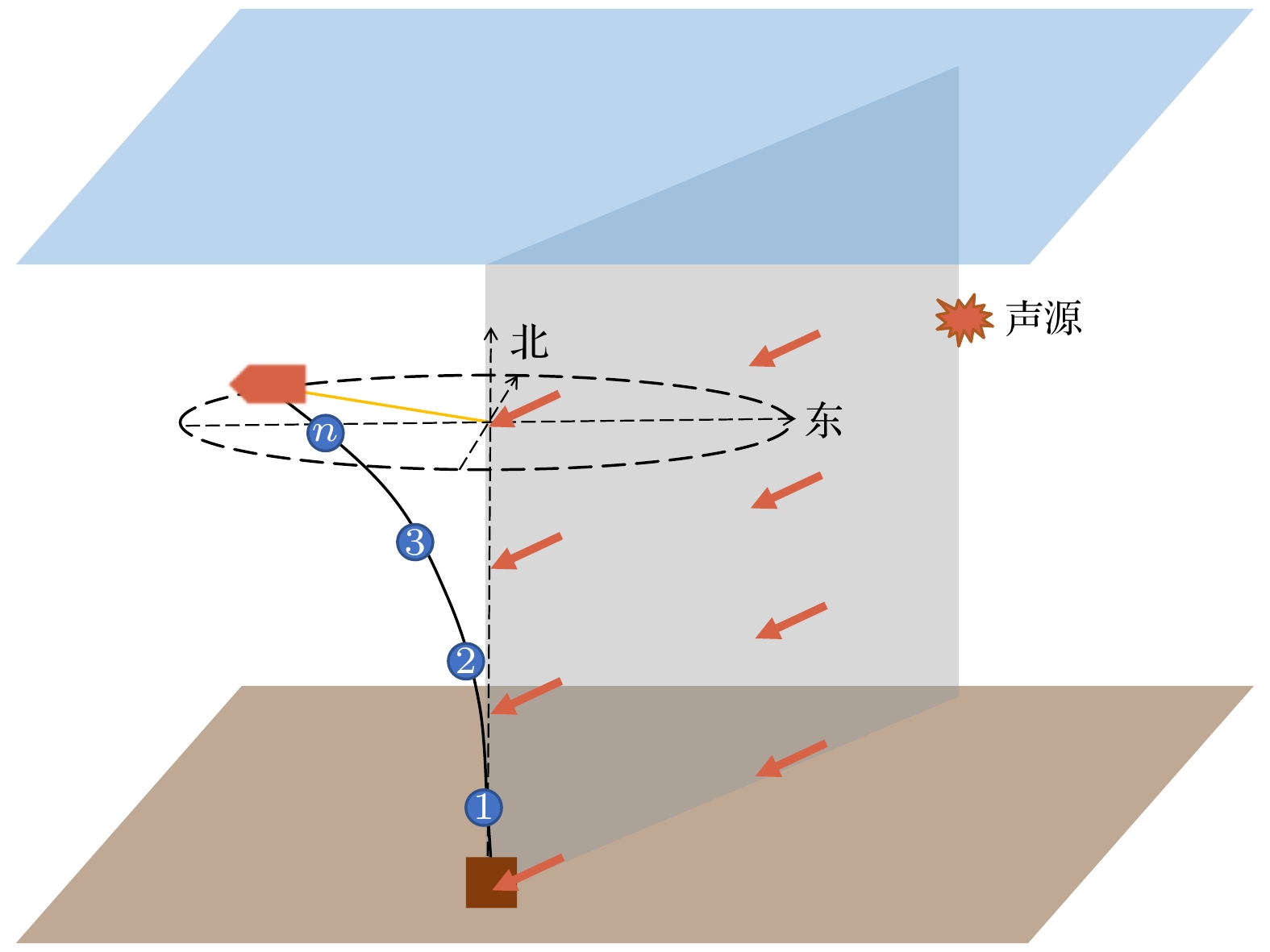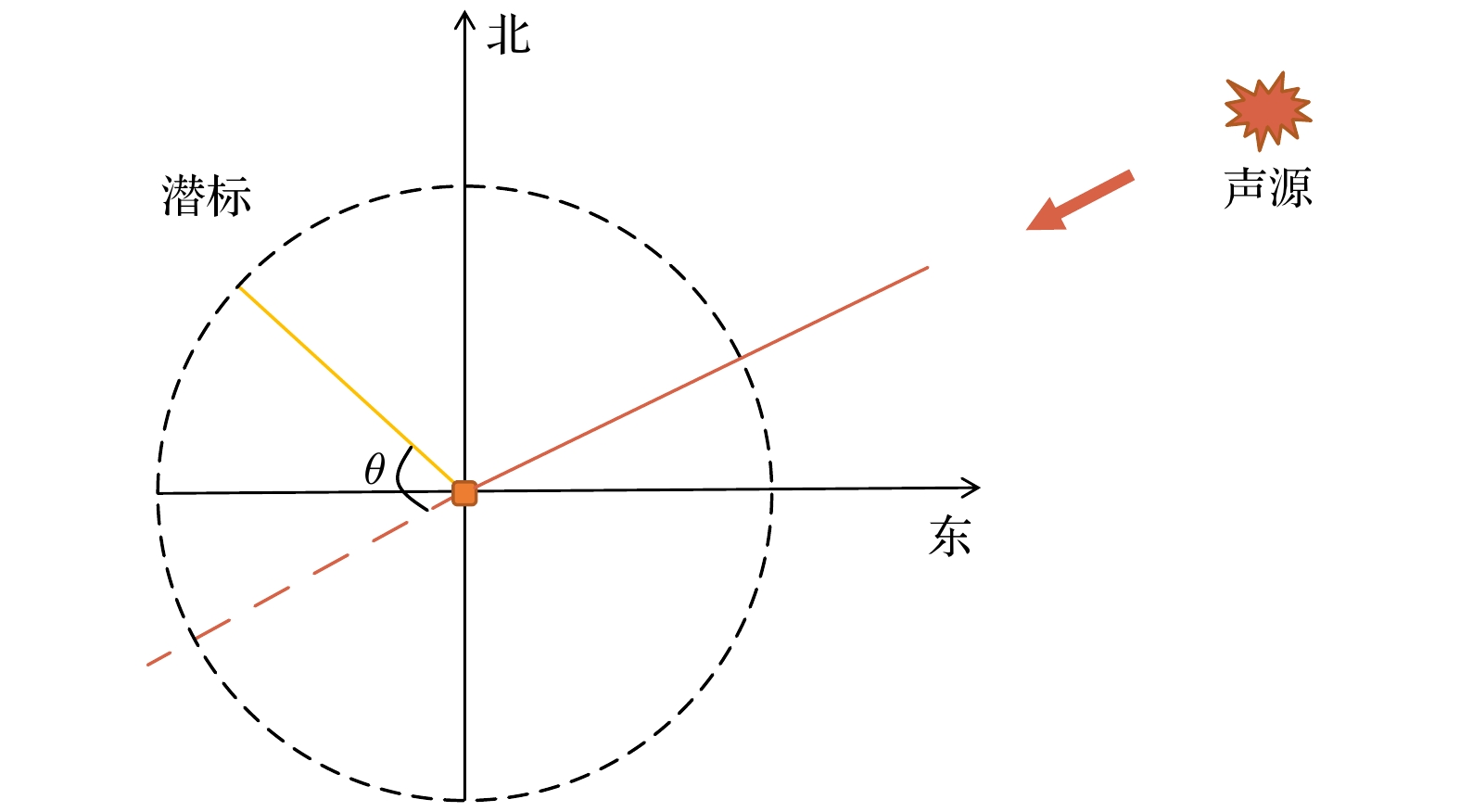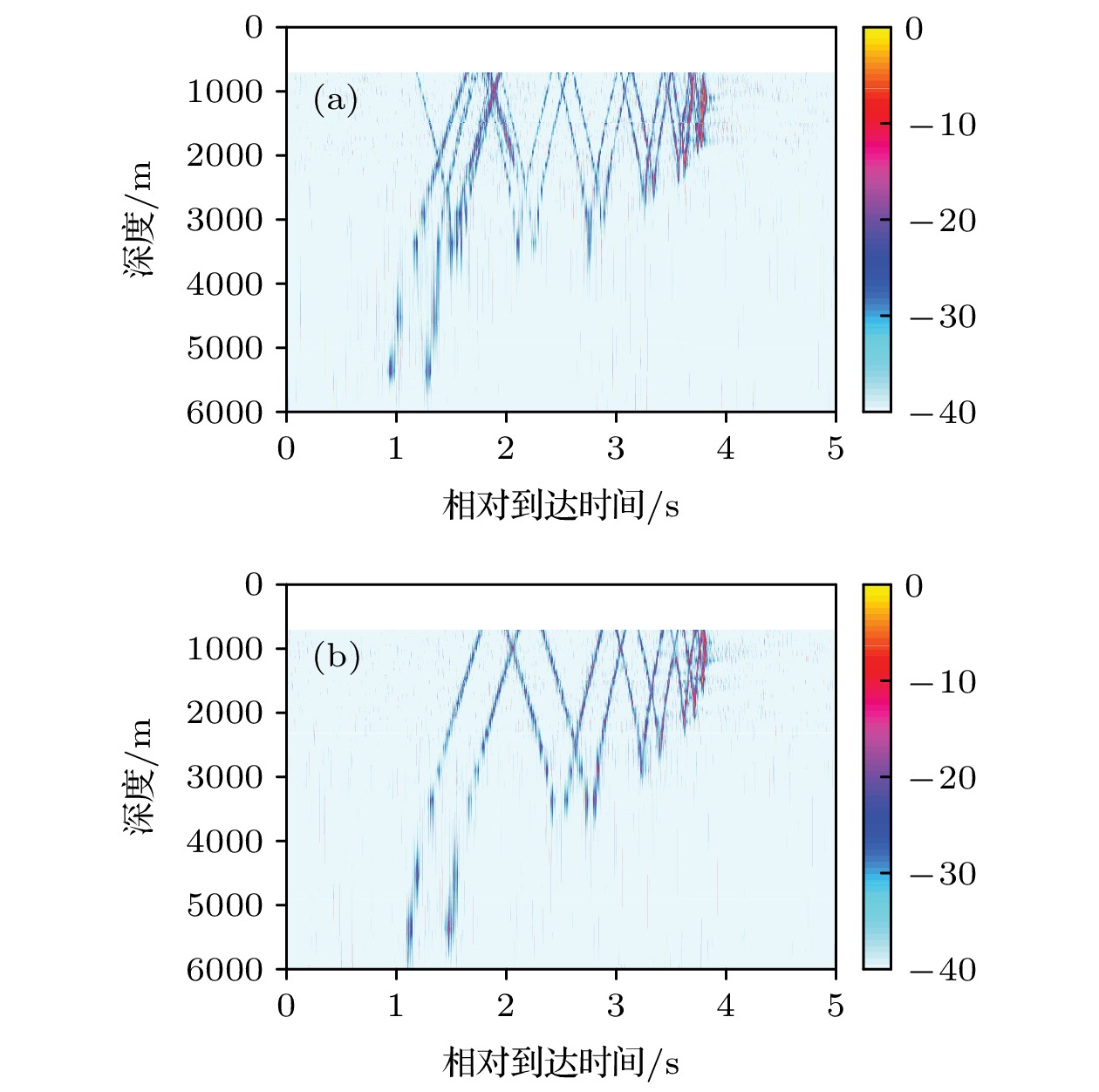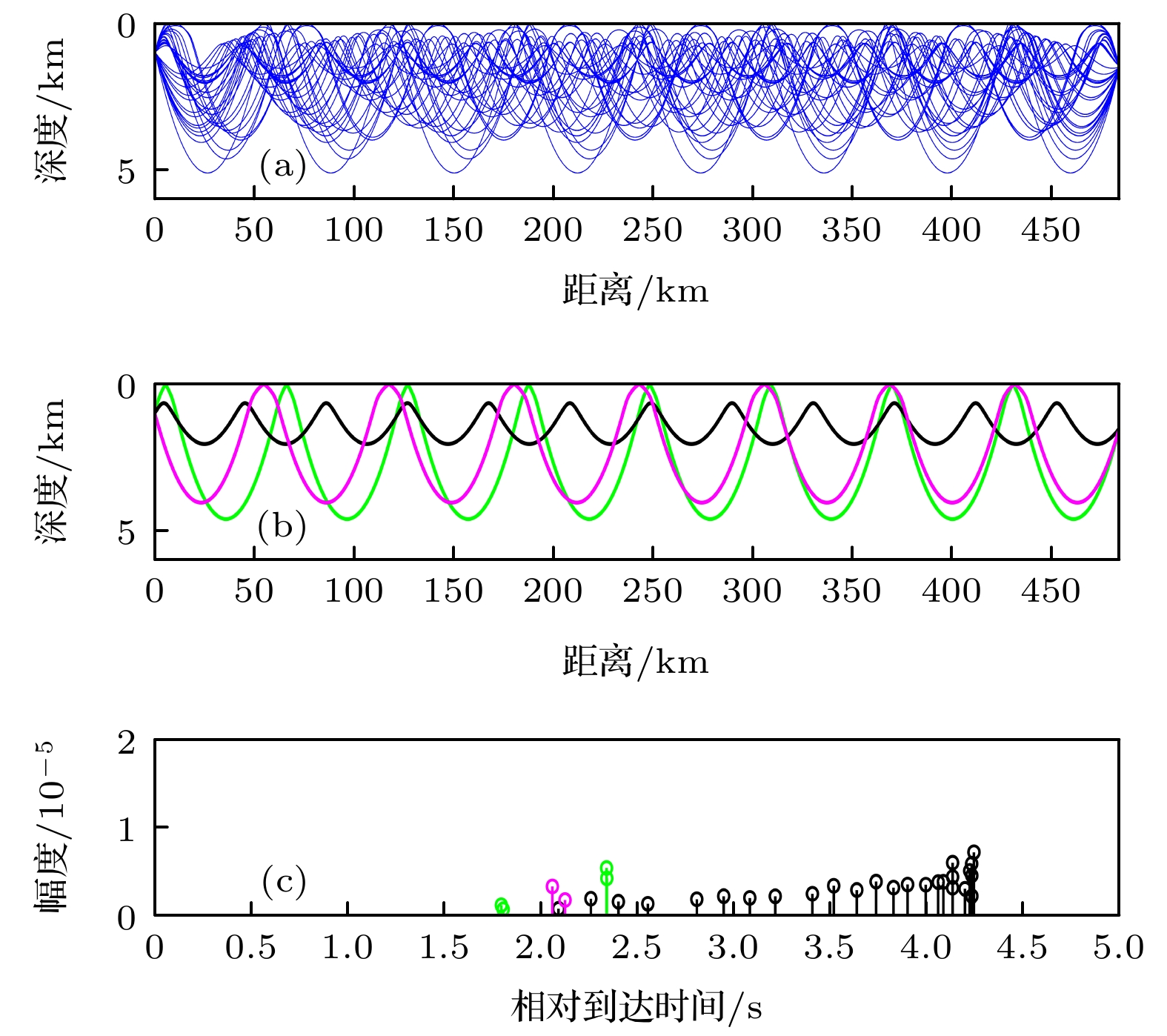-
声信号在海水中能够传播上千千米, 远距离声传播与近距离声传播的特性不同. 本文利用西太平洋声源与接收最远距离近2000 km的水声实验数据, 对实验海区的海洋环境信息、实验使用的接收垂直阵信息进行处理, 分析大洋完全声道环境下, 远距离声传播能量衰减规律和多途到达结构特性. 在远距离传播能量衰减规律方面, 随着传播距离增大, 海水吸收对声能衰减的作用凸显, 海水吸收系数的选取对声场能量预报的准确性至关重要. 较低频信号海水吸收较小, 中心频率100 Hz的声信号, 传播距离从1000—2000 km, 传播损失仅增大6 dB左右. 深海声道远距离声传播多途到达结构特性方面, 实验海区温跃层声速较高, 使得到达接收点的本征声线数目更多, 多途到达结构更复杂, 海面反射声线形成的到达结构处在整体到达结构的靠前位置, 且能量相对较强; 受西北太平洋副热带模态水的影响, 声速剖面存在双跃层结构, 导致部分声线到达接收点的时间较早, 多途到达结构在时间轴上的长度延长.Acoustic signals can travel thousands of kilometers in seawater, and the characteristics of long-range sound propagation are different from short range propagation. This paper is based on a long-range underwater acoustic experimental data obtained from the western Pacific Ocean, where the farthest propagation distance is nearly 2000 km. The ocean environment information and vertical line array information are carefully processed. We analyze the attenuation of long-distance acoustic propagation in seawater and multi-path arrival structure characteristics under the complete acoustic channel environment of the ocean. In terms of the attenuation law of long-distance propagation energy, with the increase of propagation distance, the effect of seawater absorption on the attenuation of sound energy becomes prominent, and the selection of absorption coefficient is very important for the accurate prediction of sound field energy. Absorption in seawater of low frequency signals is small, and the transmission loss of acoustic signal with 100 Hz center frequency increases only by about 6 dB when the propagation distance increases from 1000 km to 2000 km. In terms of multi-path arrival structure characteristics of deep-sea acoustic channel for long-distance sound propagation, the thermocline sound velocity profile in the experimental sea area has a higher sound speed, making the number of eigenrays reaching the receiving point more and the multi-path arrival structure more complex. The arrival structure formed by sea surface reflected eigenrays is at the earlier position of the overall arrival structure and has relatively strong energy. Owing to the influence of subtropical water over the northwest Pacific Ocean on the sound speed profile, the time of some eigenrays arriving at the receiving point is earlier, and the length of multi-way arrival structure on the time axis is prolonged.
-
Keywords:
- long-rang sound propagation /
- transmission loss /
- arrival structure
[1] Worcester P F, Cornuelle B D, Hildebrand J A, Hodgkiss W, Spindel R C 1994 J. Acoust. Soc. Am. 95 3118
 Google Scholar
Google Scholar
[2] Worcester P F, Cornuelle B D, Dzieciuch M A, et al. 1999 J. Acoust. Soc. Am. 105 3185
 Google Scholar
Google Scholar
[3] Colosi J 2004 J. Acoust. Soc. Am. 116 1538
 Google Scholar
Google Scholar
[4] Vera M, Heaney K D 2005 J. Acoust. Soc. Am. 117 1624
 Google Scholar
Google Scholar
[5] Mercer J A, Colosi J A, Howe B M, Dzieciuch M A, Stephen R 2009 IEEE J. Oceanic. Eng. 34 1
 Google Scholar
Google Scholar
[6] Worcester P F, Dzieciuch M A, Mercer J A, et al. 2013 J. Acoust. Soc. Am. 134 3359
 Google Scholar
Google Scholar
[7] Wu L L, Peng Z H 2015 Chin. Phys. Lett. 32 094302
 Google Scholar
Google Scholar
[8] Guthrie A N 1974 J. Acoust. Soc. Am. 56 58
 Google Scholar
Google Scholar
[9] Beilis A 1983 J. Acoust. Soc. Am. 68 171
 Google Scholar
Google Scholar
[10] Boyles C A 1978 J. Acoust. Soc. Am. 64 S74
 Google Scholar
Google Scholar
[11] 张仁和, 何怡 1994 自然科学进展: 国家重点实验室通讯 6 32
Zhang R H, He Y 1994 Prog. Nat. Sci. 6 32
[12] 秦继兴, 张仁和, 骆文于, 吴立新, 江磊, 张波 2014 声学学报 39 145
 Google Scholar
Google Scholar
Qin J X, Zhang R H, Luo W Y, Wu L X, Jiang L, Zhang B 2014 Acta Acust. 39 145
 Google Scholar
Google Scholar
[13] Colosi J A, Scheer E K, Flatté S, et al. 1999 J. Acoust. Soc. Am. 105 3202
 Google Scholar
Google Scholar
[14] Van Uffelen L, Worcester P F, Dzieciuch M A, Rudnick D L 2009 J. Acoust. Soc. Am. 125 3569
 Google Scholar
Google Scholar
[15] Van Uffelen L, Worcester P F, Dzieciuch M A, Rudnick D L, Colosi J A 2010 J. Acoust. Soc. Am. 127 2169
 Google Scholar
Google Scholar
[16] Kim H J 2009 Ph. D. Dissertation (Boston: Massachusetts Institute of Technolog)
[17] 韩梅, 陆娟娟 2009 计算机仿真 26 11
 Google Scholar
Google Scholar
Han M, Lu J J 2009 Comp. Simulat. 26 11
 Google Scholar
Google Scholar
[18] 吴丽丽 2017 博士学位论文 (北京: 中国科学院声学研究所)
Wu L L 2017 Ph. D. Dissertation (Beijing: The Institute of Acoustics of the Chinese Academy of Sciences) (in Chinese)
[19] 张燕 2017 硕士学位论文 (北京: 中国科学院声学研究所)
Zhang Y 2017 M. S. Thesis (Beijing: The Institute of Acoustics of the Chinese Academy of Sciences) (in Chinese)
[20] 侯温良, 龚敏, 陈东荣 1989 声学技术 8 3
Hou W L, Gong M, Chen D R 1989 Tech. Acoust. 8 3
[21] Locarnini R A, Mishonov A V, Baranova O K, et al. 2018 World Ocean Atlas (Volume 1: Temperature) 81 52
[22] Zweng M M, Reagan J R, Seidov D, et al. 2018 World Ocean Atlas (Volume 2: Salinity) 82 50
[23] Gandin L S 1963 Objective Analysis of Meteorological Fields (translated from the Russian) p184
[24] 毕思昭, 彭朝晖 2021 70 114303
 Google Scholar
Google Scholar
Bi S Z, Peng Z H, 2021 Acta Phys. Sin. 70 114303
 Google Scholar
Google Scholar
[25] Amante C, Eakins B W 2009 Psychologist 16 3
 Google Scholar
Google Scholar
[26] Susanne B, Martin W 1976 Deck41 Surficial Seafloor Sediment Description Database (NOAA National Centers for Environmental Information)
[27] Straume E O, Gaina C, Medvedev S, Hochmuth K, Gohl K, Whittaker J M, Abdul Fattah R, Doornenbal J C, Hopper J R 2019 Geochem. Geophy. Geosy. 20 4
 Google Scholar
Google Scholar
[28] Collins M 1998 J. Acoust. Soc. Am. 93 1736
 Google Scholar
Google Scholar
[29] 李整林, 董凡辰, 胡治国, 吴双林 2019 68 134305
 Google Scholar
Google Scholar
Li Z L, Dong F C, Hu Z G, Wu S L 2019 Acta Phys. Sin. 68 134305
 Google Scholar
Google Scholar
[30] Jensen F, Kuperman W, Porter M, Schmidt H 2011 Computational Ocean Acoustics (2nd Ed.) (New York: Springer-Verlag)
[31] Fisher, H. F 1977 J. Acoust. Soc. Am 62 13
 Google Scholar
Google Scholar
[32] Lovett, Jack R 1980 J. Acoust. Soc. Am 67 338
 Google Scholar
Google Scholar
[33] 刘伯胜, 雷家煜 2010 水声学原理 (北京: 科学出版社) 第141页
Liu B S, Lei J Y 2009 Principles of Undewater Acoustics (Beijing: Science Press) p141 (in Chinese)
[34] Munk W H 1974 J. Acoust. Soc. Am. 55 220
 Google Scholar
Google Scholar
-
-
[1] Worcester P F, Cornuelle B D, Hildebrand J A, Hodgkiss W, Spindel R C 1994 J. Acoust. Soc. Am. 95 3118
 Google Scholar
Google Scholar
[2] Worcester P F, Cornuelle B D, Dzieciuch M A, et al. 1999 J. Acoust. Soc. Am. 105 3185
 Google Scholar
Google Scholar
[3] Colosi J 2004 J. Acoust. Soc. Am. 116 1538
 Google Scholar
Google Scholar
[4] Vera M, Heaney K D 2005 J. Acoust. Soc. Am. 117 1624
 Google Scholar
Google Scholar
[5] Mercer J A, Colosi J A, Howe B M, Dzieciuch M A, Stephen R 2009 IEEE J. Oceanic. Eng. 34 1
 Google Scholar
Google Scholar
[6] Worcester P F, Dzieciuch M A, Mercer J A, et al. 2013 J. Acoust. Soc. Am. 134 3359
 Google Scholar
Google Scholar
[7] Wu L L, Peng Z H 2015 Chin. Phys. Lett. 32 094302
 Google Scholar
Google Scholar
[8] Guthrie A N 1974 J. Acoust. Soc. Am. 56 58
 Google Scholar
Google Scholar
[9] Beilis A 1983 J. Acoust. Soc. Am. 68 171
 Google Scholar
Google Scholar
[10] Boyles C A 1978 J. Acoust. Soc. Am. 64 S74
 Google Scholar
Google Scholar
[11] 张仁和, 何怡 1994 自然科学进展: 国家重点实验室通讯 6 32
Zhang R H, He Y 1994 Prog. Nat. Sci. 6 32
[12] 秦继兴, 张仁和, 骆文于, 吴立新, 江磊, 张波 2014 声学学报 39 145
 Google Scholar
Google Scholar
Qin J X, Zhang R H, Luo W Y, Wu L X, Jiang L, Zhang B 2014 Acta Acust. 39 145
 Google Scholar
Google Scholar
[13] Colosi J A, Scheer E K, Flatté S, et al. 1999 J. Acoust. Soc. Am. 105 3202
 Google Scholar
Google Scholar
[14] Van Uffelen L, Worcester P F, Dzieciuch M A, Rudnick D L 2009 J. Acoust. Soc. Am. 125 3569
 Google Scholar
Google Scholar
[15] Van Uffelen L, Worcester P F, Dzieciuch M A, Rudnick D L, Colosi J A 2010 J. Acoust. Soc. Am. 127 2169
 Google Scholar
Google Scholar
[16] Kim H J 2009 Ph. D. Dissertation (Boston: Massachusetts Institute of Technolog)
[17] 韩梅, 陆娟娟 2009 计算机仿真 26 11
 Google Scholar
Google Scholar
Han M, Lu J J 2009 Comp. Simulat. 26 11
 Google Scholar
Google Scholar
[18] 吴丽丽 2017 博士学位论文 (北京: 中国科学院声学研究所)
Wu L L 2017 Ph. D. Dissertation (Beijing: The Institute of Acoustics of the Chinese Academy of Sciences) (in Chinese)
[19] 张燕 2017 硕士学位论文 (北京: 中国科学院声学研究所)
Zhang Y 2017 M. S. Thesis (Beijing: The Institute of Acoustics of the Chinese Academy of Sciences) (in Chinese)
[20] 侯温良, 龚敏, 陈东荣 1989 声学技术 8 3
Hou W L, Gong M, Chen D R 1989 Tech. Acoust. 8 3
[21] Locarnini R A, Mishonov A V, Baranova O K, et al. 2018 World Ocean Atlas (Volume 1: Temperature) 81 52
[22] Zweng M M, Reagan J R, Seidov D, et al. 2018 World Ocean Atlas (Volume 2: Salinity) 82 50
[23] Gandin L S 1963 Objective Analysis of Meteorological Fields (translated from the Russian) p184
[24] 毕思昭, 彭朝晖 2021 70 114303
 Google Scholar
Google Scholar
Bi S Z, Peng Z H, 2021 Acta Phys. Sin. 70 114303
 Google Scholar
Google Scholar
[25] Amante C, Eakins B W 2009 Psychologist 16 3
 Google Scholar
Google Scholar
[26] Susanne B, Martin W 1976 Deck41 Surficial Seafloor Sediment Description Database (NOAA National Centers for Environmental Information)
[27] Straume E O, Gaina C, Medvedev S, Hochmuth K, Gohl K, Whittaker J M, Abdul Fattah R, Doornenbal J C, Hopper J R 2019 Geochem. Geophy. Geosy. 20 4
 Google Scholar
Google Scholar
[28] Collins M 1998 J. Acoust. Soc. Am. 93 1736
 Google Scholar
Google Scholar
[29] 李整林, 董凡辰, 胡治国, 吴双林 2019 68 134305
 Google Scholar
Google Scholar
Li Z L, Dong F C, Hu Z G, Wu S L 2019 Acta Phys. Sin. 68 134305
 Google Scholar
Google Scholar
[30] Jensen F, Kuperman W, Porter M, Schmidt H 2011 Computational Ocean Acoustics (2nd Ed.) (New York: Springer-Verlag)
[31] Fisher, H. F 1977 J. Acoust. Soc. Am 62 13
 Google Scholar
Google Scholar
[32] Lovett, Jack R 1980 J. Acoust. Soc. Am 67 338
 Google Scholar
Google Scholar
[33] 刘伯胜, 雷家煜 2010 水声学原理 (北京: 科学出版社) 第141页
Liu B S, Lei J Y 2009 Principles of Undewater Acoustics (Beijing: Science Press) p141 (in Chinese)
[34] Munk W H 1974 J. Acoust. Soc. Am. 55 220
 Google Scholar
Google Scholar
计量
- 文章访问数: 6759
- PDF下载量: 100
- 被引次数: 0














 下载:
下载:


